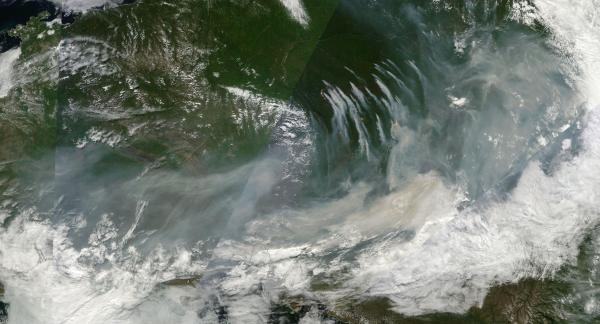Hauntingly Freakish Siberian Wildfires Now Flicker to Life in April
24
April, 2017
This
past winter has been ridiculously warm for large sections of Siberia.
From the Yamal
Peninsula to Lake
Baikal to
the thinning ice of the Arctic Ocean and back down to the Sea
of Okhotsk, temperatures
have ranged from 4 to nearly 7 degrees Celsius above normal
throughout the entire first quarter of 2017.
(4th
Consecutive year of extreme Siberian cold season warmth brings with
it the heightened risk of early wildfires. Image source: NASA
GISS.)
Climate
reanalysis shows
these far above average temperatures extending well into April. And,
as a result, the Arctic chill that typically settles over this
often-frozen region has been greatly reduced throughout winter and on
into early spring.
2017
marks the 4th
consecutive year of excessive winter warmth for this section of our
world.
A human-emissions-driven rise of abnormal heat that brings with it
consistently earlier thaws, disruptive permafrost melt, and the
freeing of new, deep-running, peat-like fuels for wildfires. A fuel
that can smolder on through winter to again mar the land with new
surface fires once the thin covering of snow draws back. An event
that is occurring earlier and earlier as the decades and the great
outpourings of oil, gas, and coal based carbon into the atmosphere
wear on.
(Multiple
wildfires and hotspots visible in this Sunday, April 22nd LANCE
MODIS satellite
shot of Siberia.)
On
Saturday, April 22nd, the
same day that tens of thousands of people marched to support climate
scientists besieged by amoral corporate and political powers linked
to the fossil fuel industry, multiple small fires flared along the
thawing edge of that greatly warmed Siberia. A number of the more
western blazes, intense enough to emit smoke plumes visible in these
LANCE-MODIS satellite shots, appeared to have already expanded to
over 1,000 acres.
By
Sunday, the fires sparking closer to Lake Baikal further east had
also grown their own series of tell-tale smoke plumes. One particular
blaze in central Siberia appeared to have produced a 2.5 x 6 mile
long burn scar in just one day (about 10,000 acres).
(40×60
mile section of Central Siberia on April 23 of 2017 shows large
wildfires burning near the thaw line. Image source: LANCE
MODIS.)
This
year’s early wildfire eruption in Siberia comes after 2014,
2015, and 2016 wildfire outbreaks during similar timeframes and
following similarly abnormal warm periods. These fires tended to crop
up south of Lake Baikal or closer to the China-Russia border. This
year, the early fire outbreak appears to have emerged both further
north and generally along a wider expanse than during past years.
If
past years are any guide, we can expect the present fire season’s
early start to produce blazes that continue through September and
that peak sometime during late June through August. The fires will
tend to be very large and will probably range as far north as the
Arctic Ocean.
(By
summer, wildfires in Siberia are now capable of repeatedly producing
massive smoke plumes like this 2,500 mile long monstrosity that was
visible from 1 million miles away in space during a 2014 event. Image
source: LANCE
MODIS.)
These
fires will gain ignition from new Arctic thunderstorms. They will be
fed by new fuels such as thawing permafrost and trees harmed by
northward invading species or by climates warming at rates far faster
than they can handle. And they will be capable of casting off
gigantic smoke plumes that encircle the higher latitude reaches of
the globe.
Instances
of this kind are the upshot of new climate change related impacts. We
wouldn’t have expected such a vast amount of Arctic and near Arctic
burning over a 5 month fire season during the 19th or 20th Centuries.
But the new very large cold-region fire outbreaks are happening in a
world at around 1.2 C hotter than 1880s averages and warming. And,
unfortunately, if we keep warming, we can expect a considerable
worsening of these already troubling events.
Links:
Hat
tip to Wili
Hat
tip to Colorado Bob







No comments:
Post a Comment
Note: only a member of this blog may post a comment.